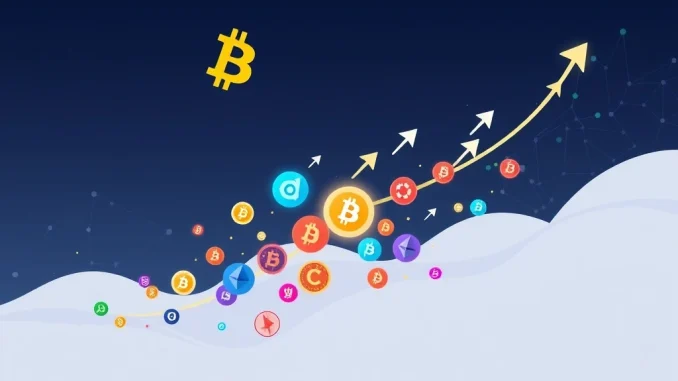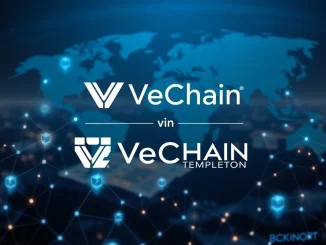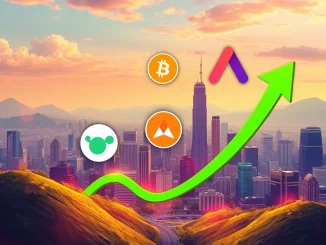
A seismic shift is underway in the cryptocurrency landscape, with over $1.2 billion redirecting from traditional large-cap assets towards a select group of high-utility altcoins. This remarkable movement, observed between mid-September and mid-October, signals a growing appetite for innovation and efficiency within the digital asset space. Investors are increasingly prioritizing projects that offer tangible solutions to real-world problems, driving a significant crypto investment shift towards platforms engineered for speed, cost-efficiency, and scalability.
The Great Altcoin Migration: Why Now?
For years, Bitcoin and Ethereum have dominated the crypto narrative, but a new wave of altcoins is now capturing significant attention and capital. Market analysts are pointing to a clear trend: a repositioning within the sector where capital is flowing into assets that promise superior performance and utility. The driving force behind this migration? A pressing demand for scalable blockchain solutions that can handle increasing transaction volumes without succumbing to high fees or network congestion.
This period has seen five specific altcoins—Sei (SEI), Algorand (ALGO), Arbitrum (ARB), Hedera (HBAR), and Velo (VELO)—emerge as frontrunners, each demonstrating price surges of up to 300% in just 30 days. This rapid growth suggests a renewed confidence in alternative ecosystems, especially as Bitcoin’s market dominance has shown signs of stabilization rather than aggressive expansion.
Deep Dive: The Top 5 Altcoins Fueling This Crypto Investment Shift
Let’s take a closer look at the specific digital assets that are at the heart of this investment phenomenon, and what makes them stand out:
Sei (SEI): The High-Speed Trading Champion
Sei has rapidly garnered attention for its optimized layer-1 infrastructure, specifically designed to reduce latency and support high-speed trading. In a market where milliseconds matter, Sei’s architecture is proving to be a game-changer. On-chain data reveals a significant surge in transaction volume, with analysts attributing its impressive 3x growth to its unique ability to handle network congestion efficiently. The project’s strategic integration of various trading protocols has further capitalized on the increased activity across the altcoin market, positioning it as a preferred platform for decentralized finance (DeFi) traders.
Algorand (ALGO): Sustainable and Enterprise-Ready Digital Assets
Algorand has been steadily gaining traction, primarily driven by its exceptionally low-fee structure and an expanding ecosystem for smart contract deployment. Experts frequently highlight ALGO’s strong focus on sustainability—a critical factor for many institutional and enterprise clients—and its appeal to businesses looking to migrate from higher-cost, less efficient chains. ALGO’s recent performance marks a stark contrast to its prior underperformance, signaling a significant reversal in market sentiment and solidifying its position as a key player in providing scalable blockchain solutions for the future.
Arbitrum (ARB): Ethereum’s Scalability Powerhouse
As a leading Layer 2 scaling solution for Ethereum, Arbitrum has significantly benefited from the rising demand for efficient transaction processing on the Ethereum network. With Ethereum’s mainnet often facing congestion and high gas fees, Arbitrum provides a vital relief valve, enabling faster and cheaper transactions. This has led to a surge in liquidity and decentralized application (dApp) activity on its network. Observers describe Arbitrum’s network structure as ‘lucrative and dynamic,’ allowing it to thrive during periods of high network traffic and proving its worth as a crucial piece of blockchain innovation.
Hedera (HBAR): Enterprise Blockchain Innovation at Scale
Hedera has seen renewed interest, largely due to its robust enterprise integrations and its highly energy-efficient governance model, powered by its unique hashgraph consensus mechanism. Analysts point to the burgeoning NFT and tokenization activity on its platform as clear indicators of its robust and highly capable infrastructure. With its market capitalization reaching $11.67 billion, Hedera is demonstrating its potential to host large-scale applications and manage significant transaction loads, making it a prime example of successful blockchain innovation in the enterprise sector.
Velo (VELO): Real-World Utility in Cross-Border Payments
Velo has notably outpaced many mid-cap altcoin trends, primarily driven by its focus on cross-border payment utility and strategic partnerships within the Southeast Asian corridor. Analysts emphasize its increasing liquidity pool interactions and a steady rise in wallet creation rates as compelling evidence of its real-world applicability and growing adoption. VELO’s ability to facilitate efficient and low-cost international transactions positions it as a key player in the evolution of global finance, showcasing practical applications of digital assets.
Beyond the Gains: Understanding Sector Repositioning
The current crypto investment shift is more than just a fleeting trend; it underscores a fundamental repositioning within the cryptocurrency sector. Investors are clearly prioritizing attributes like scalability, low transaction costs, and tangible real-world utility over mere speculative potential. While large-cap coins such as Bitcoin and Ethereum undoubtedly retain their dominant positions as foundational pillars of the crypto economy, the significant influx of capital into these specific altcoins suggests a proactive search for alternatives that directly address the existing limitations of older blockchain technologies.
This phenomenon aligns with historical cycles of sector rotation within financial markets, where capital periodically moves from established assets to emerging ones that promise higher growth potential or offer solutions to evolving market demands. The sustained interest in these projects highlights a maturing market that values utility and technological advancement.
Navigating the Market: Actionable Insights for Digital Assets Investors
For investors looking to participate in this dynamic market, understanding the underlying drivers of this crypto investment shift is crucial. Here are some actionable insights:
- Research Beyond the Hype: While impressive gains are attractive, delve into the whitepapers, teams, and use cases of each project. Focus on fundamental value.
- Assess Scalability and Efficiency: Prioritize projects that offer genuine scalable blockchain solutions, as these are likely to maintain relevance in the long term.
- Diversify Your Portfolio: While specific altcoins are surging, a balanced portfolio that includes established assets alongside promising newcomers can mitigate risk.
- Monitor Real-World Utility: Projects with clear, demonstrable real-world applications (like cross-border payments or enterprise solutions) tend to have stronger staying power.
- Stay Informed on Regulatory Clarity: The sustainability of gains in the crypto market is often tied to the evolving regulatory landscape.
Challenges and Considerations in the Altcoin Landscape
While the recent performance of these altcoins is exciting, market watchers caution that the sustainability of these gains depends on broader economic conditions and, crucially, regulatory clarity across different jurisdictions. The crypto market remains inherently volatile, and rapid gains can be followed by swift corrections. Investors must conduct thorough due diligence and be aware of the risks associated with speculative assets. Factors like network security, developer activity, and community support also play a vital role in the long-term viability of any blockchain innovation.
Conclusion: The Future of Crypto Investment
The recent reallocation of over $1.2 billion into a handful of high-utility altcoins marks a pivotal moment in the cryptocurrency market. This significant crypto investment shift highlights a growing preference for scalable blockchain solutions and projects offering tangible real-world utility. As the industry matures, the focus is increasingly on foundational blockchain innovation that can support the next generation of decentralized applications and services. While the journey of these digital assets will undoubtedly have its ups and downs, the current trend suggests a compelling future where efficiency, utility, and genuine technological advancement drive market value.
Frequently Asked Questions (FAQs)
1. What is driving the recent $1.2 billion shift into altcoins?
The shift is primarily driven by investor demand for more efficient, cost-effective, and scalable blockchain solutions. Many investors are seeking alternatives to larger, more established cryptocurrencies that can sometimes suffer from high transaction fees and network congestion. The selected altcoins offer improved performance and real-world utility.
2. Which five altcoins have seen significant investment and gains?
The five altcoins highlighted in this investment shift are Sei (SEI), Algorand (ALGO), Arbitrum (ARB), Hedera (HBAR), and Velo (VELO). Each of these projects has demonstrated substantial price surges, some up to 300% in 30 days, reflecting renewed market confidence.
3. What makes these altcoins attractive to investors?
These altcoins are attractive due to their focus on key features like optimized layer-1 infrastructure (Sei), low-fee structures and sustainability (Algorand), Layer 2 scalability for Ethereum (Arbitrum), enterprise integrations and energy efficiency (Hedera), and real-world utility in cross-border payments (Velo). They offer solutions to common blockchain limitations.
4. Does this shift indicate the end of Bitcoin’s dominance?
Not necessarily. While Bitcoin and Ethereum remain dominant, this shift indicates a diversification of investment and a search for alternatives that address specific blockchain limitations. It suggests a maturing market where capital is also flowing into innovative projects offering unique value propositions, rather than solely concentrating on the top two.
5. What are the risks associated with investing in these high-growth altcoins?
Investing in high-growth altcoins carries significant risks, including high volatility, susceptibility to broader economic conditions, and evolving regulatory uncertainties. While the potential for high returns exists, investors should be prepared for potential rapid price corrections and conduct thorough due diligence before investing.



